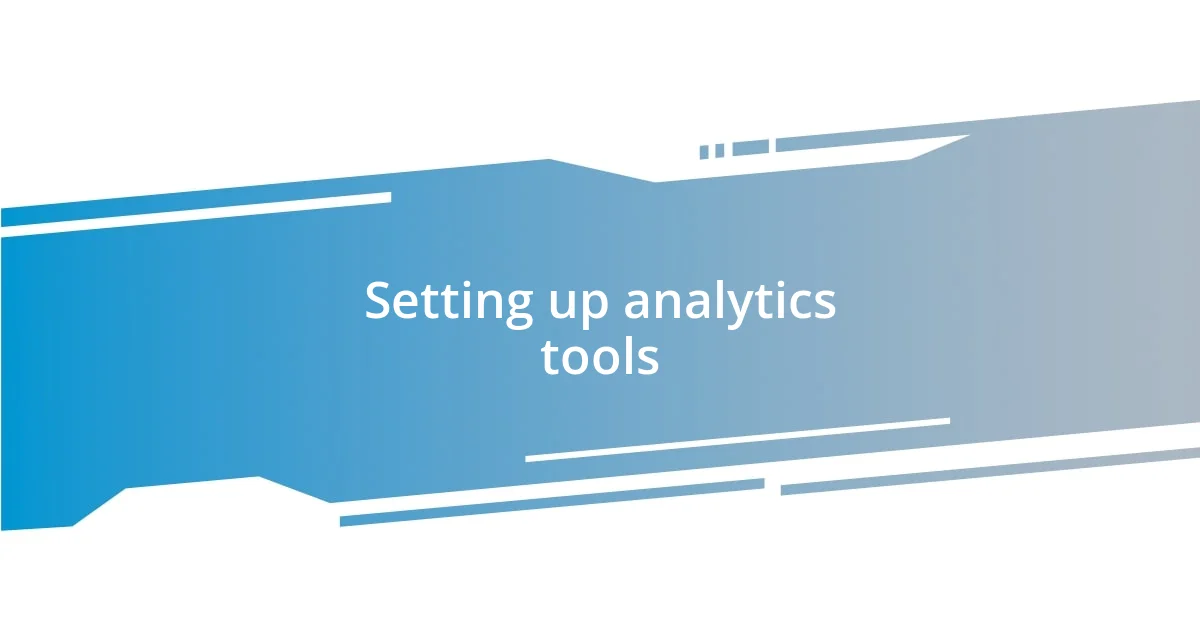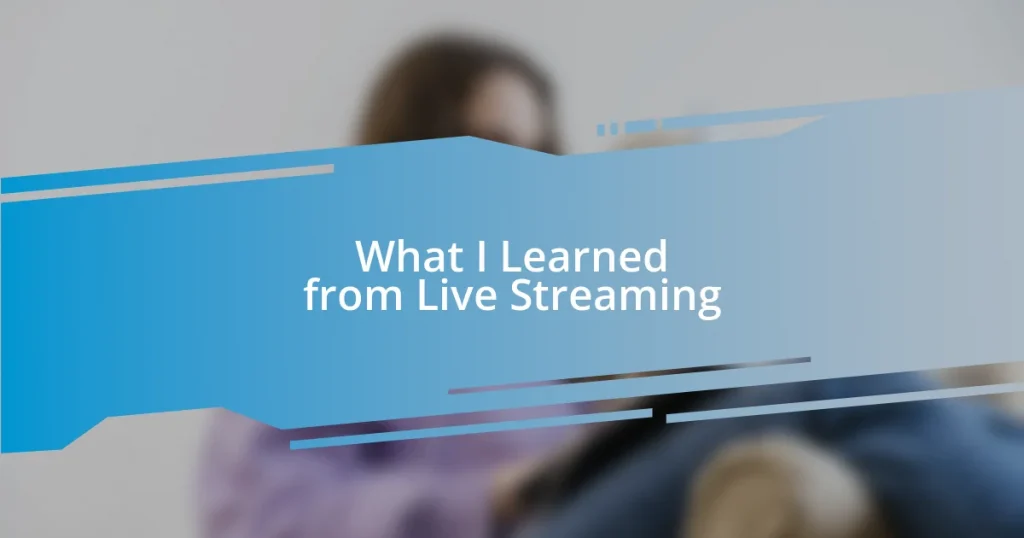Key takeaways:
- Understanding and analyzing video analytics helps identify viewer engagement, retention patterns, and demographic insights for more tailored content.
- Utilizing tools like Google Analytics and YouTube Analytics to track performance metrics allows creators to refine their content strategy effectively.
- Continuous improvement through experimentation, viewer feedback, and trend observation enhances video performance and strengthens audience connection.

Understanding video analytics
Understanding video analytics is like peering through a window into your audience’s mind. It reveals what keeps viewers engaged, highlighting aspects like watch time and viewer retention. I’ll never forget the first time I noticed a significant drop-off point in one of my videos; it was eye-opening. Why didn’t I catch that sooner?
When I began to dive deeper into analytics, I discovered the importance of audience demographics and geographic data. Seeing where my viewers were located felt almost personal—it’s as if I was building a connection with them. Does knowing the age group and interests of my audience make a difference? Absolutely! Tailoring content becomes way more meaningful when I understand who I’m speaking to.
I’ve also learned to appreciate engagement metrics like likes, shares, and comments. Every thumbs up feels like a small victory, while every comment is an opportunity for connection and feedback. Have you ever wondered which part of your video sparked the most discussion? I still remember the comments I received on a video where I passionately shared a personal experience—it sparked a heartfelt conversation among viewers. It’s those moments that remind me why understanding video analytics is so vital.

Setting up analytics tools
Setting up analytics tools is the first crucial step in unlocking the full potential of your video content. When I embraced the world of analytics, choosing the right tools felt like assembling my secret weapon. I remember the overwhelming options available, but I found that focusing on a few key platforms made all the difference.
Here are a few tools I recommend getting started with:
- Google Analytics: A comprehensive tool that tracks web traffic, helping you monitor where your viewers are coming from.
- YouTube Analytics: Specifically designed for video creators, this tool provides insights on watch time, audience demographics, and engagement metrics.
- Vimeo Analytics: For those using Vimeo, this tool offers valuable insights into viewer behavior and video performance.
- Social Media Insights: Platforms like Facebook and Instagram have their own analytics tools that can show how your videos perform across social channels.
As I set up these tools, I felt a mix of excitement and nerves, unsure of what I’d discover. I’ll never forget the moment I connected Google Analytics with my site—it was like flipping a switch. Suddenly, I could see what resonated with my audience, leading me to refine my content strategy.

Interpreting key metrics
Interpreting key metrics can be a game changer when it comes to enhancing your videos. I remember painstakingly analyzing each metric after a video launch, something which initially felt tedious. However, once I spotted trends, it was like discovering hidden treasures within my data. For instance, tracking watch time helped me identify which segments held viewers’ attention and which parts caused them to lose interest. Those insights led me to refine my video scripts for clarity and engagement.
Delving into audience retention is another aspect I’ve grown to appreciate. I recall a specific video where the retention graph showed steep drops at certain intervals. I decided to create a more attention-grabbing introduction for my next project, and the results were astonishing—my viewers stuck around longer. Seeing direct improvements in engagement made me realize how vital it is to continuously learn from these metrics.
Engagement rates, too, tell an incredibly rich story. I vividly remember the time my video received an unexpected surge in comments and shares. Upon checking the analytics, I discovered that a particular visual effect I used seemed to resonate with my audience. This experience taught me the importance of experimenting with new techniques, ensuring I keep my content fresh and exciting for the viewers.
| Metric | Importance |
|---|---|
| Watch Time | Indicates how long viewers stay engaged with your video, helping you adjust content pacing. |
| Audience Retention | Identifies points where viewers drop off, guiding you to improve future videos. |
| Engagement Rate | Measures interaction through likes, comments, and shares, revealing what resonates with your audience. |

Identifying viewer engagement patterns
Recognizing viewer engagement patterns is like piecing together a puzzle. I remember the first time I analyzed the specific moments when viewers dropped off—I was shocked to see how just a few seconds of awkward silence led to a significant drop in engagement. It was a wake-up call for me! I realized that every second counts in maintaining interest and had to rethink how I structured my videos from that moment on.
Analyzing the comments section is also a goldmine for engagement patterns. I often reflect on the feedback I received after introducing a new segment in my videos. When I noticed an influx of enthusiastic comments about the change, it confirmed that my audience was craving more interactive content. So ask yourself: what is your audience telling you? Their insights can often direct you towards creating videos that not only keep them watching but also encourage meaningful interaction.
Another vital aspect I discovered is the timing of my uploads. Initially, I posted whenever it was convenient for me, but then I started experimenting with different days and times. One particular video released on a Friday evening garnered significantly more views than my usual Sunday uploads. It made me feel energized to see such a positive response. Could it be possible that your audience is waiting for you to find the right time to connect? I believe understanding these engagement patterns is essential in crafting videos that consistently resonate and build a loyal viewer base.

Optimizing content based on data
I’ve found that optimizing content based on data requires a willingness to experiment and adapt. For instance, I once analyzed the thumbnails of my videos, noticing that those featuring bright colors and bold text received significantly higher click-through rates. Intrigued, I decided to revise previous thumbnails to match this successful trend. The boost in views felt exhilarating, and it occurred to me that small changes could yield such substantial impacts.
In addition to visual elements, I also focus on the titles I use. After a video underperformed, I revisited the title and realized it lacked urgency and emotional appeal. I restructured it to evoke curiosity and excitement, and when I re-released the video with the updated title, it was hard not to feel a thrill as the views climbed. Isn’t it fascinating how just the right words can spark interest? Data-driven tweaks like this reshape our approach, leading to what I like to think of as creative breakthroughs.
Content length can also be a game-changer. I used to think longer videos equated to more value. I recall my surprise when a shorter, succinct video outperformed my longer ones. Delving into analytics, I recognized my audience preferred bite-sized, actionable content. This realization sparked a delightful shift in how I create videos, motivating me to deliver valuable insights efficiently. What if you narrowed down your content, focusing on clarity and impact? The potential results could be eye-opening!

Testing changes and measuring impact
Testing changes in my videos has been an eye-opening experience. I remember the first time I tweaked the format by switching from longer intro segments to brief, punchy openings. After analyzing viewer retention, the difference was stark; viewers stayed engaged for longer, which was thrilling to see. Isn’t it interesting how such a simple change can lead to a more dynamic viewer experience?
When I implement a new change, I always set a timeline to measure its impact effectively. For example, I once tested adding a viewer poll during a video, encouraging immediate feedback. I monitored the analytics closely during the following weeks, and the response was overwhelmingly positive; both engagement and interaction increased significantly. Has testing your content changes led you to unexpected insights too? I’ve found that patience and consistent observation are crucial to truly grasping what resonates with my audience.
Measuring the impact of my adjustments often goes beyond the immediate results. I’ve developed a habit of revisiting past videos to see how small shifts have changed the course of my content, like altering the call-to-action. I may not have noticed immediately, but one video led to a spike in subscriptions that felt rewarding. It makes me ponder: how often do we underestimate the long-term benefits of carefully testing our changes? Embracing a mindset of continuous learning has truly enriched my video creation journey.

Continuous improvement strategies
Continuous improvement is a mindset that has transformed my approach to video creation. For instance, I once decided to experiment with incorporating more interactive elements, such as clickable links and annotations. When I reviewed the analytics post-implementation, the engagement metrics skyrocketed. It’s fascinating to see how encouraging viewers to participate actively not only enhances their experience but also boosts my overall video performance. Have you ever thought about how interactive features could elevate your content?
Alongside interactive content, I’ve also focused on soliciting more in-depth feedback from my audience. During a live Q&A session, I asked viewers what they wanted more of in my videos. The insights were incredibly valuable, revealing topics I had overlooked. This experience solidified the idea that my audience knows best what they crave. How often do we neglect to ask our viewers about their preferences? Building a continuous feedback loop has been a game changer for me.
Furthermore, I regularly dedicate time to reviewing trends within my niche. Recently, I noticed a rising interest in behind-the-scenes content. By integrating this format into my channel, I not only satisfied viewer curiosity but also established a more personal connection with my audience. This shift taught me the importance of being attuned to industry shifts and viewer interests. Are you keeping a pulse on what’s evolving in your content area? Engaging with these trends not only drives improvement but also anticipates viewer needs, ensuring your content remains relevant and engaging.
















